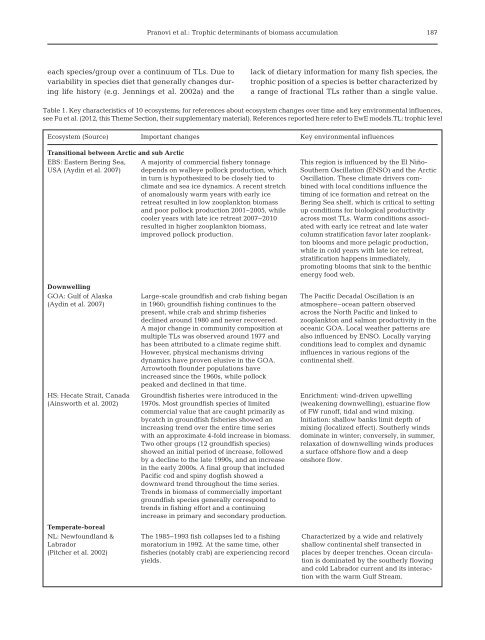Complete Theme Section in pdf format - Inter Research
Complete Theme Section in pdf format - Inter Research
Complete Theme Section in pdf format - Inter Research
Create successful ePaper yourself
Turn your PDF publications into a flip-book with our unique Google optimized e-Paper software.
Pranovi et al.: Trophic determ<strong>in</strong>ants of biomass accumulation 187<br />
each species/group over a cont<strong>in</strong>uum of TLs. Due to<br />
variability <strong>in</strong> species diet that generally changes dur<strong>in</strong>g<br />
life history (e.g. Jenn<strong>in</strong>gs et al. 2002a) and the<br />
lack of dietary <strong>in</strong><strong>format</strong>ion for many fish species, the<br />
trophic position of a species is better characterized by<br />
a range of fractional TLs rather than a s<strong>in</strong>gle value.<br />
Table 1. Key characteristics of 10 ecosystems; for references about ecosystem changes over time and key environmental <strong>in</strong>fluences,<br />
see Fu et al. (2012, this <strong>Theme</strong> <strong>Section</strong>, their supplementary material). References reported here refer to EwE models.TL: trophic level<br />
Ecosystem (Source) Important changes Key environmental <strong>in</strong>fluences<br />
Transitional between Arctic and sub Arctic<br />
EBS: Eastern Ber<strong>in</strong>g Sea, A majority of commercial fishery tonnage<br />
USA (Ayd<strong>in</strong> et al. 2007) depends on walleye pollock production, which<br />
<strong>in</strong> turn is hypothesized to be closely tied to<br />
climate and sea ice dynamics. A recent stretch<br />
of anomalously warm years with early ice<br />
retreat resulted <strong>in</strong> low zooplankton biomass<br />
and poor pollock production 2001−2005, while<br />
cooler years with late ice retreat 2007−2010<br />
resulted <strong>in</strong> higher zooplankton biomass,<br />
improved pollock production.<br />
Downwell<strong>in</strong>g<br />
GOA: Gulf of Alaska<br />
(Ayd<strong>in</strong> et al. 2007)<br />
HS: Hecate Strait, Canada<br />
(A<strong>in</strong>sworth et al. 2002)<br />
Temperate-boreal<br />
NL: Newfoundland &<br />
Labrador<br />
(Pitcher et al. 2002)<br />
Large-scale groundfish and crab fish<strong>in</strong>g began<br />
<strong>in</strong> 1960; groundfish fish<strong>in</strong>g cont<strong>in</strong>ues to the<br />
present, while crab and shrimp fisheries<br />
decl<strong>in</strong>ed around 1980 and never recovered.<br />
A major change <strong>in</strong> community composition at<br />
multiple TLs was observed around 1977 and<br />
has been attributed to a climate regime shift.<br />
However, physical mechanisms driv<strong>in</strong>g<br />
dynamics have proven elusive <strong>in</strong> the GOA.<br />
Arrowtooth flounder populations have<br />
<strong>in</strong>creased s<strong>in</strong>ce the 1960s, while pollock<br />
peaked and decl<strong>in</strong>ed <strong>in</strong> that time.<br />
Groundfish fisheries were <strong>in</strong>troduced <strong>in</strong> the<br />
1970s. Most groundfish species of limited<br />
commercial value that are caught primarily as<br />
bycatch <strong>in</strong> groundfish fisheries showed an<br />
<strong>in</strong>creas<strong>in</strong>g trend over the entire time series<br />
with an approximate 4-fold <strong>in</strong>crease <strong>in</strong> biomass.<br />
Two other groups (12 groundfish species)<br />
showed an <strong>in</strong>itial period of <strong>in</strong>crease, followed<br />
by a decl<strong>in</strong>e to the late 1990s, and an <strong>in</strong>crease<br />
<strong>in</strong> the early 2000s. A f<strong>in</strong>al group that <strong>in</strong>cluded<br />
Pacific cod and sp<strong>in</strong>y dogfish showed a<br />
downward trend throughout the time series.<br />
Trends <strong>in</strong> biomass of commercially important<br />
groundfish species generally correspond to<br />
trends <strong>in</strong> fish<strong>in</strong>g effort and a cont<strong>in</strong>u<strong>in</strong>g<br />
<strong>in</strong>crease <strong>in</strong> primary and secondary production.<br />
The 1985−1993 fish collapses led to a fish<strong>in</strong>g<br />
moratorium <strong>in</strong> 1992. At the same time, other<br />
fisheries (notably crab) are experienc<strong>in</strong>g record<br />
yields.<br />
This region is <strong>in</strong>fluenced by the El Niño-<br />
Southern Oscillation (ENSO) and the Arctic<br />
Oscillation. These climate drivers comb<strong>in</strong>ed<br />
with local conditions <strong>in</strong>fluence the<br />
tim<strong>in</strong>g of ice <strong>format</strong>ion and retreat on the<br />
Ber<strong>in</strong>g Sea shelf, which is critical to sett<strong>in</strong>g<br />
up conditions for biological productivity<br />
across most TLs. Warm conditions associated<br />
with early ice retreat and late water<br />
column stratification favor later zooplankton<br />
blooms and more pelagic production,<br />
while <strong>in</strong> cold years with late ice retreat,<br />
stratification happens immediately,<br />
promot<strong>in</strong>g blooms that s<strong>in</strong>k to the benthic<br />
energy food web.<br />
The Pacific Decadal Oscillation is an<br />
atmosphere–ocean pattern observed<br />
across the North Pacific and l<strong>in</strong>ked to<br />
zooplankton and salmon productivity <strong>in</strong> the<br />
oceanic GOA. Local weather patterns are<br />
also <strong>in</strong>fluenced by ENSO. Locally vary<strong>in</strong>g<br />
conditions lead to complex and dynamic<br />
<strong>in</strong>fluences <strong>in</strong> various regions of the<br />
cont<strong>in</strong>ental shelf.<br />
Enrichment: w<strong>in</strong>d-driven upwell<strong>in</strong>g<br />
(weaken<strong>in</strong>g downwell<strong>in</strong>g), estuar<strong>in</strong>e flow<br />
of FW runoff, tidal and w<strong>in</strong>d mix<strong>in</strong>g.<br />
Initiation: shallow banks limit depth of<br />
mix<strong>in</strong>g (localized effect). Southerly w<strong>in</strong>ds<br />
dom<strong>in</strong>ate <strong>in</strong> w<strong>in</strong>ter; conversely, <strong>in</strong> summer,<br />
relaxation of downwell<strong>in</strong>g w<strong>in</strong>ds produces<br />
a surface offshore flow and a deep<br />
onshore flow.<br />
Characterized by a wide and relatively<br />
shallow cont<strong>in</strong>ental shelf transected <strong>in</strong><br />
places by deeper trenches. Ocean circulation<br />
is dom<strong>in</strong>ated by the southerly flow<strong>in</strong>g<br />
and cold Labrador current and its <strong>in</strong>teraction<br />
with the warm Gulf Stream.
















